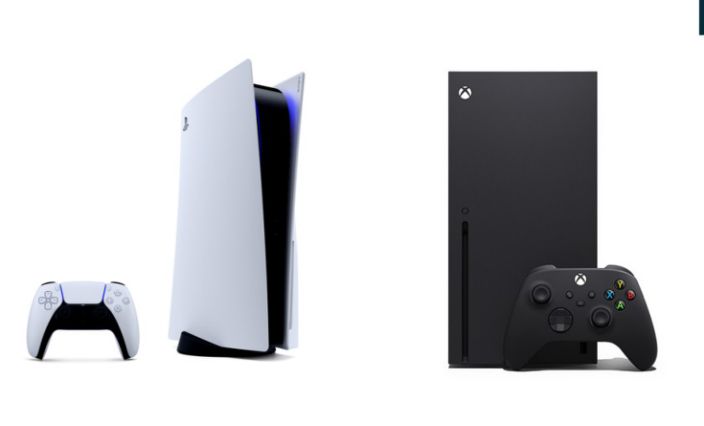Tech News
PS5, Xbox Series X and the climate crisis facing next-gen video games

This is a transformative decade for the planet. Despite the coronavirus pandemic slowing global travel, restricting industrial activity and keeping us at home for much of the year, carbon dioxide levels continue to rise. Global temperatures are soaring, and 2020 is one of the three warmest years on record. Without urgent action to arrest greenhouse gas emissions over the next decade, we could see the planet warm by more than 7 degrees Fahrenheit by 2100.
In November, against this backdrop, Sony and Microsoft released their next-generation home consoles: the PS5, the Xbox Series X and the Xbox Series S. Early sales figures show these have proven the most successful launches ever, for both companies.
Microsoft has hyped its monolithic Xbox Series X as “the fastest and most powerful” Xbox yet. Sony has touted the PlayStation 5’s load times and “incredible graphics.” Both machines render the latest video games in crisp, ultra-high-definition. Their processing power is unprecedented. They promise to deliver impossibly beautiful vistas, perfect shadows, radiant light and living, breathing worlds direct to your TV for the next decade.
But the impressive technological leap and record-breaking sales come with a high environmental cost. In April, I predicted the next generation of gaming could generate more carbon emissions than ever before. Over the past few weeks, we have put that prediction to the test, analyzing the energy output of the PlayStation 5, Xbox Series S and Xbox Series X in an array of experiments designed to estimate the carbon footprint of each console.
The results are striking. While Sony and Microsoft have made progress in driving down energy expended during streaming, idling and at rest, our investigation reveals that playing the latest, big-budget titles results in energy use significantly higher than the previous generation. Sony and Microsoft have built the most energy-intensive game consoles to date, at a time when definitive action against climate change is more important than ever. And it’s not just the planet that suffers — players’ pockets take a hit from increasing energy use, too.

Bloomberg
Our data highlights a potentially diabolical problem. In its current form, the home console upgrade cycle, occurring every decade, appears unsustainable. Players want consoles to ceaselessly improve, load faster and look more impressive with each generation. Such improvements require more power, putting them at odds with many of the sustainability goals set by corporations to avert the biggest increases in global temperatures.
“We, as an industry, are beginning to truly recognize the status quo is not sustainable,” says Paula Escuadra, co-chair of the International Game Developers Association Climate Special Interest Group (IGDA Climate SIG). It’s early days, she says, and the industry’s biggest players are starting to take action. When it comes to the latest console generation, however, they may have acted too slowly.
Energized
I examined the ninth-generation home consoles — the Series S, Series X and PS5 — and compared them with their predecessors, the Xbox One X, the PS4 Pro and the Nintendo Switch. We also studied the energy output of the Alienware A9 desktop. Our methodology involves testing the kilowatt-hours, a measure of energy use, over an hour of play time. You can read more about it at this publicly accessible Google Doc.
I conducted the first series of tests on exclusive, AAA titles, studying baseline energy used over an hour of play. On the PS4 Pro and the Xbox One X, AAA titles were some of the most energy-intensive, and previous research has shown huge variability in energy use across titles. Our results confirm this is still the case in the ninth generation.
Take, for instance, Spider-Man: Miles Morales for the PS5. Every hour, it uses 197 watts of power, or 0.197kWh of energy. Demon’s Souls, another PS5 launch title, uses approximately 0.220kWh, whereas Gears 5, on the Xbox Series X, uses around 0.209kWh.
This considerable variability makes it difficult to analyze the carbon footprint of an average player. Other factors, such as how long players use their console each week and whether they’ve downloaded a title or are using a disc, also define individual carbon outputs. Nevertheless, our analysis provides some startling numbers, particularly in regard to the direction that AAA video games in the ninth generation are heading.

Andrew Hoyle/CNET
Per user, per household, the carbon emissions generated while playing video games is small — but not insignificant. An hour of play in Spider-Man Miles Morales is equivalent to charging your smartphone 18 times. At scale, we can see how quickly things might get out of control.
Over 13 million people bought the original Spider-Man on the PS4. Let’s say 10 million people buy Miles Morales on the PS5. The game takes about 15 hours to complete, but not everyone is going to achieve that. Let’s say only 10% do. That’s 100,000 people playing Miles Morales for 15 hours. Some back-of-the-napkin math suggests the carbon emitted would total around 230 tons — the same as 45 cars driven for a year, according to the EPA.
For comparison, Nintendo’s Breath of the Wild uses a mere 0.01kWh. If 100,000 people play for 15 hours, the carbon emitted is equivalent to just 2.3 cars. A staggering difference.
But let’s go even bigger. Almost 70 million people have bought a Nintendo Switch since release in March 2017. If they play AAA, exclusive titles for two hours per week, on average, using just 0.01kWh each hour, only 56,000 tons of carbon dioxide will be generated each year. Apply the same logic to the PS5 and assume it will also sell 70 million units. With Sony’s console, over 1.1 million tons of carbon dioxide will be generated. The Xbox would see similar numbers.
Energy darlings
Home consoles have also experienced an influx of indie titles over the past decade, and these fare better in my testing. Typically, these games are made by smaller development teams on tighter (or non-existent) budgets, but they can still include eye-popping visuals without pushing console processing power to the limit. In this analysis, we focused on Dead Cells, a critically acclaimed 2018 rogue-lite with a 2D pixel art aesthetic.
The Series X averaged about 0.084 kWh of energy an hour, a power draw similar to the Xbox One X. The PS5 used 0.077kWh, reducing energy use by about 30% over the PS4 Pro, which used about 0.091kWh of energy. The Alienware A9 performed slightly better at just 0.070kWh, while the Series S was impressive, only using 0.05kWh.
These numbers don’t seem significant, but they’re particularly remarkable when you compare them with energy used by the Nintendo Switch. Dead Cells only uses one-tenth the amount of energy when played on a Switch compared with the Xbox Series X, with just 0.007kWh consumed.

Motion Twin
While the resolution of the games differs across consoles, there’s little improvement in the experience based on energy output. The gameplay is largely unchanged between consoles, and graphical fidelity plays little role in the enjoyment of Dead Cells. Unless someone told you explicitly which console you were playing on, it would be hard to tell the difference.
In questioning the need for this excess power in indie titles, Microsoft and Sony did not respond to specific requests for comment. However, a Microsoft spokesperson told CNET the company is “looking for ways to make our products more energy efficient including using a technique to reduce the amount of power used while gaming.”
Energy royale
The most concerning increase in energy use this generation comes from one of the world’s most popular titles: Fortnite. Although the battle royale’s dominance of the video game world has waned in the past year, it’s still a force to be reckoned with. It’s available on practically any gadget that has a screen, and creator Epic Games says there are over 350 million registered accounts across all devices.
On the ninth generation of consoles, its energy use is extreme. The PS5 is the worst offender, using 0.216kWh of energy — the highest recorded for the title and comparable to Demon’s Souls. The Xbox Series X comes in second at 0.178kWh. On both those consoles, Fortnite runs at 4K resolution and 60 FPS, with developer Epic noting these versions also contain “dynamic visuals and physics.”
The Xbox Series S, which only runs at 1080p, is impressive here. It uses just 0.076kWh — a dramatic decrease from its beefier console counterpart. If we again look at Nintendo’s Switch, we find it’s using just 0.014kWh — five times less than the Series S, 12 times less than the X and 15 times less than the PS5. The Switch can’t hit the same resolutions and FPS as the latest consoles, so the discrepancies make sense — but they’re substantial when viewed side by side.

Datawrapper
A carbon-conscious consumer would certainly look at these numbers and turn away from the ninth-generation consoles. Yes, Fortnite looks immaculate and runs smoothly on the PS5 and Series X, but the tradeoff is a doubling of energy use and an extremely high carbon footprint.
That isn’t just a net negative for the planet, either. Energy costs money. Playing Fortnite on the PS5 or Xbox Series X will hit your pocket, too. Depending on your average use, you could pay anywhere between $10 and $50 a year on the PS5 just powering Fortnite, but you’d pay maximum $3 or $4 if you did the same using the Switch.
Saving energy
Though the energy draw while gaming is high, Sony and Microsoft have made improvements in energy use and sustainability in their new consoles.

Energy-saving opportunities are now baked in to the initial startup. When you first boot up a new console and are guided through the setup, prompts encourage you to consider energy-saving settings. For the Xbox Series S and X, these settings are no different from the power mode options in the Xbox One X. The two options are “Instant On” and “Energy Saving.” Without energy-saving settings, the new consoles draw between 10 and 20 watts, but with them switched on, the numbers drop to a barely perceptible 1 watt. Similar levels are seen in the PS5 with energy-saving settings at their highest level.
Xbox’s Instant On allows you to turn the console on with your voice and download in the background. The PS5 also allows background downloads and USB charging in its default energy settings. The energy-saving modes switch these features off. There is a convenience trade-off here, and it’s at odds with the two titans’ core mission. These consoles are built to be switched on quickly and allow you to jump directly into whatever it is you’re looking to do, whether that be a game or a streaming service. Which prompts the question: How many users will use energy-saving settings?
The console makers also tout their new consoles as multimedia devices, equipped to deliver video in 4K via streaming services like Netflix, Disney+ and Amazon Prime Video. Both Sony and Microsoft have made clear gains in energy efficiency in this area. The PS5’s energy use while streaming is down 29% compared to the PS4, but largely unchanged compared to the PS4 Pro, whereas both the Series S and Series X have decreased by around 40% compared to the Xbox One X. Comparing the two, Microsoft is on top. Streaming on the Series consoles consumes around 0.045kWh, while the PS5 uses around 0.063kWh.

Video game companies acknowledge their environmental impacts. All three console manufacturers subscribe to the European Union’s self-regulatory initiative to drive down energy use in home consoles. There’s also the United Nations’ Playing for the Planet Alliance — Sony and Microsoft are both members — designed to mobilize manufacturers, developers and publishers into making non-binding commitments to combat climate change. The UN’s push may have partly driven some of the improvements we’ve seen in streaming and idling energy use in the ninth generation.
Nintendo is not a member of the Alliance and has, in the past, been criticized for its environmental impacts. A decade ago Greenpeace ranked the Wii as the least environmentally-friendly console. But in terms of raw energy use, Nintendo consoles have been remarkably energy-efficient compared to Microsoft and Sony’s monolithic machines. This continues to be the case if you pit the Switch against the PS5 and Series S and X.
Energy transparency
These tests have just scratched the surface of the ninth generation’s energy conundrum. We’ve merely analyzed the energy output as a crude measure of carbon emissions generated while using the console.
Although use is considered the main source of emissions over a console’s lifecycle, many other factors contribute to gaming’s enlarging carbon footprint. We haven’t factored in supply chains, the mining of rare Earth minerals, the manufacturing process and end-of-life treatments such as recycling and e-waste production. We’ve not discussed the data centers, cloud streaming platforms or future technologies, like augmented reality, which may further increase energy spend.
When taking this into consideration, it’s obvious individual emissions from product use are only one small part of a monstrous machine. Decarbonizing will require decisive and swift action from the biggest corporations, including Sony and Microsoft, and the scale of the problem is immense.
It’s further complicated by a lack of clear reporting of emissions by the industry’s heaviest polluters. Video game academics, too, have tried to ascertain accurate statistics on console use, but many facets are assumed, rather than known. Without this information, it becomes impossible to fully comprehend how big the carbon footprints of next-generation consoles might be.
“It’s definitely been a challenge to understand how our industry is calculating the lifecycle of product usage,” says Escuadra, who also works as the Games User Research Lead for Google Stadia Games and Entertainment’s publishing team. “Part of it is that many companies want models to be absolutely perfect and valid before releasing them.
“It’s reasonable, but sometimes perfect can be the enemy of the good.”

The IGDA Climate SIG, which Escuadra co-chairs, has identified industry benchmarking as one of the major work streams for 2021. She says the group will work to aggregate research, calculators and models to create resources for developers who wish to understand their carbon footprint.
For consumers, it’s hard to know just how much the ninth-generation consoles will contribute to global warming. There’s simply not enough data and little focus on how energy use relates to emissions. “Some intense barriers to improved efficiency remain in place,” says Evan Mills, who led a research project on energy use in eighth-generation consoles. “Almost complete lack of consumer information and lack of incentive among the gaming-system manufacturers certainly impedes progress and smart decisions.”
There have been missteps in communication, too, leading to confusion. In September, Microsoft announced on a sustainability page it had built 825,000 carbon neutral Xbox consoles, using an image of a Series X to promote the initiative. However, the program was built around the Xbox One X. It feels particularly galling the color green, intricately tied to the environmental movement, is such a prominent marketing tool for Xbox.
In the absence of solid numbers and amid confusing marketing, some consumers have decided against purchasing a new console altogether. “I’ve been skipping this generation so far,” says Hugo Bille, a game designer and climate activist who runs the Game Devs For Future Discord. “And I’m going to try to do that as long as I can.”
Next gen-ergy
The death of the home console has been greatly exaggerated.
We’ve only just entered the ninth generation, but it seems likely we will see a 10th. In a recent interview with The Verge, Phil Spencer, head of Xbox, said he doesn’t think the Series S and Series X will “will be the last big pieces of hardware that we ship.” If the gaming industry is to confront the climate crisis and become carbon-neutral, it must begin to look at the next generation now.
The PS5 and the Series X and S were consoles built during a social turning point. Conceived and created when the world began grappling more resolutely with the climate emergency. Although scientists and researchers have been banging the climate change drum for decades, the last two years in particular have seen the tide turning on climate action. Figures like Greta Thunberg have inspired worldwide rallies, urging governments to do more to slow greenhouse gas emissions. The 10th generation of consoles will be built in this environment; a state of heightened activism as its backdrop.
Microsoft has pledged to be carbon-negative by 2030. Sony wants to have “zero environmental footprint” by 2050. These are grand commitments, and these companies lead the way in the tech space, but they are much quieter when it comes to the strategies they’ll employ in the future of their gaming businesses. You can see in the marketing for the pair’s latest consoles they are still focused on speed, power and visual improvements — all features at odds with driving down greenhouse gas emissions.
And these will be replaced by The Next Thing. Will that be gaming in the cloud, via data centers? Will it be beefier consoles again, crisper graphics, more lifelike landscapes, more realistic lighting? Will it be something revolutionary that redefines how games are played and by who, like the jump from the Gamecube to the Wii?
Whatever form they take, the next generation of consoles will be deeply impacted by climate change. We have already locked ourselves into some degree of global warming. Short of a global overhaul of our energy infrastructure and a weaning off of fossil fuels, consoles will continue to contribute to that warming — our data shows this clearly. “Each component needs to be scrutinized for opportunities,” says Mills. “CPUs, GPUs, power supplies, motherboards, displays and all the peripherals offer opportunities for savings without degrading performance.”
Escuadra is optimistic we can turn it around.
“While we have quite a ways to go before we as an industry are carbon neutral (or even negative), many major companies through the UN Play for the Planet Alliance and the IGDA Climate SIG have acknowledged the need for us to work together, promote sustainability, and mobilize 2.3 billion people around the world to protect our future,” she says.
Bille’s optimism comes in waves. He says if I ask him about the future, he’d probably give me a different answer tomorrow. Gaming isn’t going anywhere. No one wants to take games away. But we need to recognize they will change as a result of what’s to come.
“Either we decarbonize the games industry as a preventative measure, or we do it because shit’s hitting the fan,” says Bille.
“Either way, we do it.”
Source: https://www.cnet.com/features/ps5-xbox-series-x-and-the-climate-crisis-facing-next-gen-video-games/








1 Comment